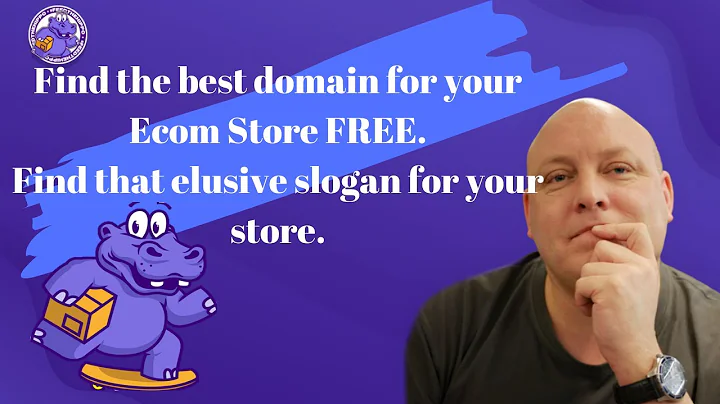Unlock the Future of E-commerce with NFTs on Shopify
Table of Contents
- Introduction
- What is an NFT?
- NFTs in the Art Industry
- NFTs for Loyalty and Rewards Programs
- NFTs for Limited Edition Drops
- NFTs for Digital Avatars
- Potential Risks of NFTs
- Conclusion
- FAQs
Minting and Selling NFTs on Shopify: A Guide for E-commerce Brands
If you're in the e-commerce industry and haven't been looking into NFTs, now is the time. NFTs have officially entered the mass market, and Shopify has made it easier than ever for merchants to create and sell their own NFTs. In this article, we'll unpack the use cases and examples of how direct-to-consumer and e-commerce brands can use NFTs.
What is an NFT?
First, let's define what an NFT is. An NFT, or non-fungible token, is a digital asset that is unique and represents ownership of something. That ownership is programmed on blockchain, which means that it's easily verifiable, secured, and transferable. In other words, an NFT is a way for people to really own digital stuff, including the ability to resell it in the physical world.
NFTs in the Art Industry
The first industry where NFTs really exploded in 2021 is art. Creators can now sell their works as NFTs that are hard-coded to generate royalties from all future resales in perpetuity. This means that every time one of their works is resold at auctions, on marketplaces, on streaming services, and so on, the actual creator is compensated directly for each of those resales along with the new seller. The important distinction that I'm trying to make here is that NFTs are not just JPEG images that are being sold for millions of dollars. NFT is a technology that allows ownership of both digital assets and benefits in the physical world.
NFTs for Loyalty and Rewards Programs
NFTs could potentially replace loyalty and rewards programs for e-commerce. You simply verify your NFT on the site and get your lifetime 20% off. As a branded NFT holder, you might also get invites to exclusive online and offline events or even have a say in what that brand does next. Because your most loyal customers don't really want another VIP program, they want to say in what you make next. And when the consumer is done with a brand, they can simply resell that NFT to someone else.
Let's look at a real case study of how NFTs can be used for loyalty and rewards from Clinique, a brand owned by Estée Lauder. Instead of selling NFTs, Clinique opened a contest for its rewards members where the winners received free products for 10 years along with an NFT artwork called Metaoptimist. The NFT is a conceptual molecule that changes colors based on the two of Clinique's most popular products: the Moisture Surge moisturizer and a lipstick called Black Honey, a 50-year-old product that sporadically goes viral on social media. People enter to win by sharing stories of optimism on Instagram, TikTok, and Twitter. The three winners receive Black Honey, which is often out of stock and is currently unavailable. In addition to once-yearly physical products, and for added excitement, the winners will be announced on social media by Clinique's ambassadors, actors Emilia Clarke and Melissa Barbera. By opening up NFT access only to its loyalty and rewards members, Clinique is both rewarding membership and incentivizing others to join the program. And by doing this through a social media contest and gifting NFTs instead of asking buyers to buy them, the brand is making it easy for everyone to participate.
NFTs for Limited Edition Drops
You can use digital products or NFTs to drive demand for physical ones. There are multiple ways to do that. One way to implement this is to make all limited edition drops gated by NFTs. In this scenario, unless you're a branded NFT holder and can verify your ownership, you can't get your hands on a limited edition collection. Imagine if Beyoncé's Ivy Park collection with Adidas was only available to Adidas NFT holders. This would create a surge in NFT sales, generating revenue for Adidas. And since those NFTs would have long-term perks, if Adidas is smart, they are essentially baking in increased customer retention because people will be coming back to redeem their perks. This would generate lots of hype, as exclusivity gated by NFTs is very real, and those NFT holders will surely flex their perks on social media. Adidas would also probably partner with Beyoncé for that NFT to also include an exclusive song or an audio message from her. Consumers that hold Adidas NFTs will now feel like a part of a very exclusive club, but the coolest thing is they can decide to sell that NFT whenever they want and cash out.
Let's go from a hypothetical to a real-life example. Hugo Boss recently introduced a TikTok challenge in which people could win five unique Boss and Russell Athletic NFT jackets as well as a physical twin. That physical jacket came with a QR code that enables the person to wear it in AR. The campaign set social media records for the brand with 3.1 million consumer-generated videos and more than seven and a half billion views. This is some serious viral effects and community building right there. The more the metaverse becomes a part of our lives, the more the growth of physical goods will be driven by the sale of virtual goods. It's a total mind shift, but it's already happening.
NFTs for Digital Avatars
Closely related to the previous point, as a brand selling physical goods, you can also create digital goods for the metaverse. NFTs will be used for digital avatars, so you'll be dressing your online persona while you're shopping for yourself. Both Nike and Adidas have been focusing on this quite a bit. Nike just acquired a digital sneaker NFT company called RTFKT. This brand, which I can't pronounce, is a digital design studio producing trainers and other collectibles that can be worn across different online environments. Adidas, on their end, made its first NFT drop created with NFT pioneers Board API Club, Gmoney, and the team behind Punk's comic. The Adidas NFTs called "Into the Metaverse" are already available for purchase, and owners receive exclusive access to various Adidas Originals experiences and products. Adidas NFTs act as an access pass to virtual land, experiences, and virtual wearables for the blockchain-based gaming world The Sandbox. Physical products which are co-branded with the same collaborators that I just mentioned include a hoodie, a tracksuit, and Gmoney's iconic orange beanie.
Potential Risks of NFTs
While NFTs offer exciting opportunities, there are also potential risks to consider. One risk is that you build it, and no one comes. With everything else you do in e-commerce, distribution, marketing, and community matter a lot. You need to start educating your audience early, build a community, and make it easy for them to participate once you launch your NFT project. On the flip side, if you launch your branded NFT, and it doesn't take off, it's likely not that big of a deal. It wouldn't be damaging to the brand or anything like that, just some time and effort spent. If your brand is still small, don't think that NFTs will be the silver bullet that will make your brand go viral. You need to start with a community of die-hard fans first.
Another risk is a lack of talent to execute cutting-edge experiences. Most brands will lack the specialized internal talent to execute full NFT campaigns, so they will likely need to partner with agencies, marketplaces, platforms, and influencers. I will assure you that there will be lots of people who will try to make a quick buck after watching a bunch of YouTube videos, so pay extra attention to references as you hire people to do this. And once you find someone who actually knows what they're doing, hold on to them.
Concerns over sustainability are also a potential risk. The crypto space has received significant criticism for lack of sustainability practices and wasting energy. The core crypto community has fired back, either refuting the challenge, comparing the efforts to gold, oil, and printed money, or promising to improve. If your brand's audience is environmentally sensitive, look into more energy-efficient blockchains such as Solana. I will link to their energy report in the video description.
Marketing spend on proven channels is another potential risk. So why waste resources? Brands can easily execute search ads, display ads, and email marketing and get a calculated, proven rate of return. So why innovate in such new waters when the mass market isn't ready? The obvious answer is to be first, learn from innovation techniques, and to plant a flag for future endeavors and the PR.
Conclusion
As you can see, the sky is the limit for the applications and utility of NFTs in commerce. We're still early and are just scratching the surface with what's possible. I believe the NFT hype will peak in 2022. There will be so many NFT projects launched at a diesel pace that it will be difficult for brands to stand out in a crowded market. As a result, brands that move in early at the beginning of the year will have an advantage and will be able to serve consumers seeking to collect and give virtual experiences and artifacts.
FAQs
Q: What is an NFT?
A: An NFT, or non-fungible token, is a digital asset that is unique and represents ownership of something. That ownership is programmed on blockchain, which means that it's easily verifiable, secured, and transferable.
Q: What are the potential risks of NFTs?
A: The potential risks of NFTs include building it, and no one comes, a lack of talent to execute cutting-edge experiences, concerns over sustainability, and marketing spend on proven channels.
Q: How can NFTs be used for loyalty and rewards programs?
A: NFTs could potentially replace loyalty and rewards programs for e-commerce. You simply verify your NFT on the site and get your lifetime 20% off. As a branded NFT holder, you might also get invites to exclusive online and offline events or even have a say in what that brand does next. Because your most loyal customers don't really want another VIP program, they want to say in what you make next. And when the consumer is done with a brand, they can simply resell that NFT to someone else.
Q: How can NFTs be used for limited edition drops?
A: You can use digital products or NFTs to drive demand for physical ones. One way to implement this is to make all limited edition drops gated by NFTs. In this scenario, unless you're a branded NFT holder and can verify your ownership, you can't get your hands on a limited edition collection.
Q: How can NFTs be used for digital avatars?
A: NFTs will be used for digital avatars, so you'll be dressing your online persona while you're shopping for yourself. Both Nike and Adidas have been focusing on this quite a bit. Nike just acquired a digital sneaker NFT company called RTFKT. This brand, which I can't pronounce, is a digital design studio producing trainers and other collectibles that can be worn across different online environments.






















